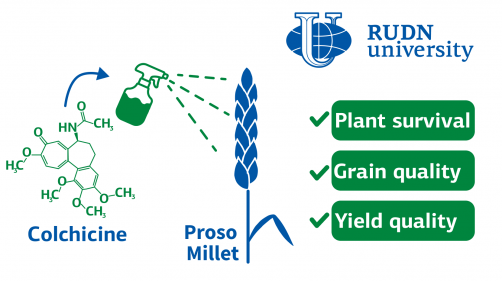RUDN University agronomists have shown that in low concentrations colchicine improves millet yield and grain quality. Besides, it does not hurt the genetic diversity of subsequent generations. The results were published in Agronomy.
Newswise — To develop a crop with the desired characteristics, biologists cross suitable samples of the same or different plants. However, this simple method does not apply to self-pollinating crops. In this case, a relatively quick method to obtain the required plant characteristics is to artificially induce mutations. To do this, they use colchicine, a natural nitrogen-containing compound that interferes with the process of cell division - mitosis - and provokes mutations. To use this “mitotic poison” for good, one needs to know the right concentrations for each crop. For self-pollinating millet, scientists do not have such information. Millet is inferior to other cereals in terms of productivity, but superior in resistance to adverse conditions. RUDN University agronomists have shown that with colchicine, it is possible to control millet mutations and increase its yield, and also calculated the concentration of the substance required for this.
“Mutation breeding is a fast way to improve self-pollinating crops. Artificial mutations improve the agronomic properties and quantitative characteristics of plants - yield, disease resistance, grain or fruit quality. In addition, mutations can cause the appearance of new traits that were not there before or that disappeared during long-term cultivation,” Meisam Zargar, Doctor of Agricultural Sciences, Associate Professor of the RUDN University Agrobiotechnological Department said.
Agronomists studied how different concentrations of colchicine—from 0.04 to 0.1%—and different treatment durations—from 6 to 24 hours—affect the characteristics of switchgrass. For the experiment, we used millet genotypes from different countries: Kazakhstan, Russia, and Hungary.
The largest number of mutations occurred when treated with 0.08–0.1% colchicine, but the consequences were negative - the germination and yield of the crop decreased. The optimal conditions turned out to be average values for both concentration and duration of treatment. This approach increased the average indicators of plant survival, grain quality, tillering, and yield. For the three genotypes, the numbers vary significantly, but for example, in the Russian sample, when treated with colchicine at a concentration of 0.06% for 6 hours, the yield increased from 35–43 centners per hectare to 44–46.
“We found that colchicine treatment can be an effective tool for regulating the agronomic traits of millet while maintaining genetic diversity,” Meisam Zargar, Doctor of Agricultural Sciences, Associate Professor of the RUDN University Agrobiotechnological Department said.
